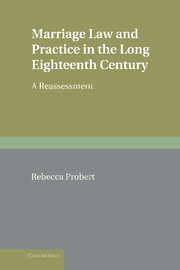Book contents
- Frontmatter
- Contents
- Preface
- 1 Introduction
- 2 The misunderstood contract per verba de praesenti
- 3 The myths of ‘informal’ and ‘common-law’ marriage
- 4 The little-considered marriage practices of non-Anglicans
- 5 The unacknowledged regularity of clandestine marriages
- 6 The eventual passage and actual terms of the 1753 Act
- 7 The unappreciated success of the 1753 Act
- 8 The unexplored judicial interpretation of the 1753 Act
- 9 The overlooked response of non-Anglicans
- 10 Conclusion
- Index
- References
2 - The misunderstood contract per verba de praesenti
Published online by Cambridge University Press: 10 February 2010
- Frontmatter
- Contents
- Preface
- 1 Introduction
- 2 The misunderstood contract per verba de praesenti
- 3 The myths of ‘informal’ and ‘common-law’ marriage
- 4 The little-considered marriage practices of non-Anglicans
- 5 The unacknowledged regularity of clandestine marriages
- 6 The eventual passage and actual terms of the 1753 Act
- 7 The unappreciated success of the 1753 Act
- 8 The unexplored judicial interpretation of the 1753 Act
- 9 The overlooked response of non-Anglicans
- 10 Conclusion
- Index
- References
Summary
The prevailing view that the 1753 Act marked a radical shift in the regulation of marriage is based in large part on the hypothesis that prior to 1754 all that was required to create a marriage was the exchange of consent by the individuals concerned, and that as a consequence couples had no need or desire to marry in church. This chapter, by contrast, will show that an exchange of consent was not a full alternative to regular marriage – in that it did not carry the same legal rights as one celebrated before an Anglican minister – and that it was not regarded by contemporaries in the same way as such a marriage. As a result, couples had no option but to observe the rites and rules demanded by the law.
But if this was the case, then why has such a different view been advanced by other commentators? As with many myths, there is an underlying substratum of facts that are not in dispute. Lawyers today may point to the fact that it is still (technically) possible to enter into a marriage by a simple exchange of consent in certain limited circumstances as evidence that this was possible prior to the 1753 Act. But reading history backwards is a dangerous matter.
- Type
- Chapter
- Information
- Marriage Law and Practice in the Long Eighteenth CenturyA Reassessment, pp. 21 - 67Publisher: Cambridge University PressPrint publication year: 2009



